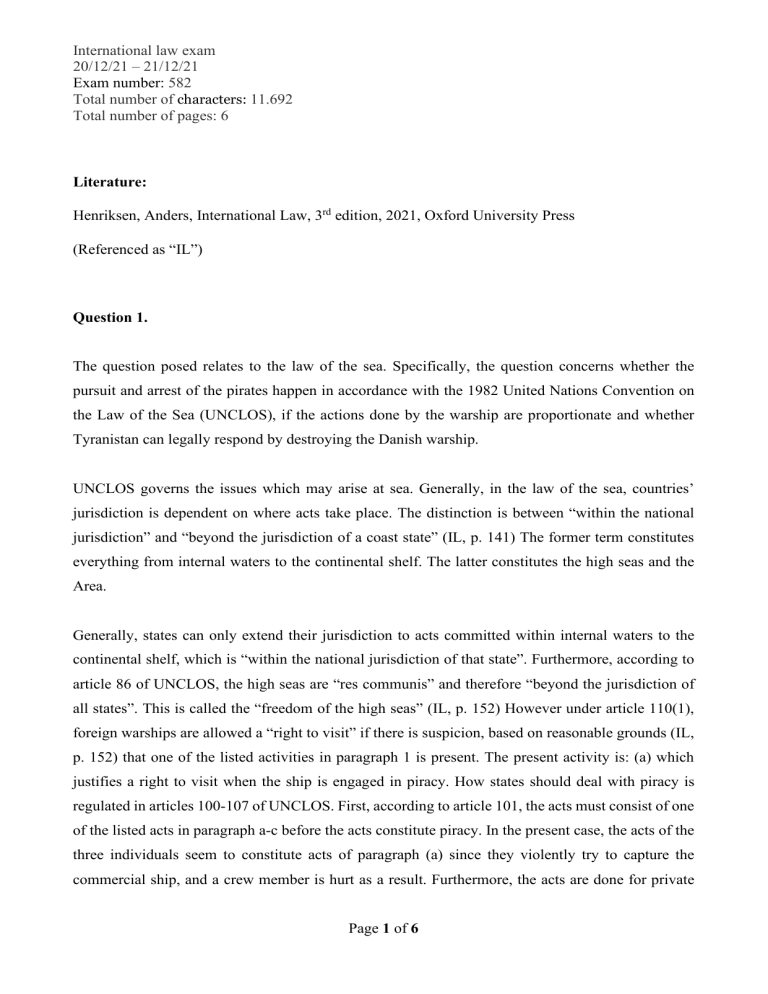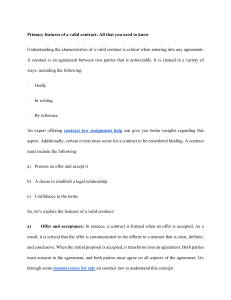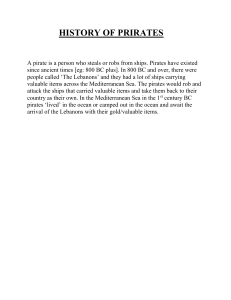International Law Exam: Law of the Sea, State Responsibility
advertisement

International law exam 20/12/21 – 21/12/21 Exam number: 582 Total number of characters: 11.692 Total number of pages: 6 Literature: Henriksen, Anders, International Law, 3rd edition, 2021, Oxford University Press (Referenced as “IL”) Question 1. The question posed relates to the law of the sea. Specifically, the question concerns whether the pursuit and arrest of the pirates happen in accordance with the 1982 United Nations Convention on the Law of the Sea (UNCLOS), if the actions done by the warship are proportionate and whether Tyranistan can legally respond by destroying the Danish warship. UNCLOS governs the issues which may arise at sea. Generally, in the law of the sea, countries’ jurisdiction is dependent on where acts take place. The distinction is between “within the national jurisdiction” and “beyond the jurisdiction of a coast state” (IL, p. 141) The former term constitutes everything from internal waters to the continental shelf. The latter constitutes the high seas and the Area. Generally, states can only extend their jurisdiction to acts committed within internal waters to the continental shelf, which is “within the national jurisdiction of that state”. Furthermore, according to article 86 of UNCLOS, the high seas are “res communis” and therefore “beyond the jurisdiction of all states”. This is called the “freedom of the high seas” (IL, p. 152) However under article 110(1), foreign warships are allowed a “right to visit” if there is suspicion, based on reasonable grounds (IL, p. 152) that one of the listed activities in paragraph 1 is present. The present activity is: (a) which justifies a right to visit when the ship is engaged in piracy. How states should deal with piracy is regulated in articles 100-107 of UNCLOS. First, according to article 101, the acts must consist of one of the listed acts in paragraph a-c before the acts constitute piracy. In the present case, the acts of the three individuals seem to constitute acts of paragraph (a) since they violently try to capture the commercial ship, and a crew member is hurt as a result. Furthermore, the acts are done for private Page 1 of 6 International law exam 20/12/21 – 21/12/21 Exam number: 582 Total number of characters: 11.692 Total number of pages: 6 ends since it is done by private individuals with private intentions. In addition, it does not stem from internal hijacking and as the acts carried out were outside any jurisdiction, the acts must constitute piracy. According to article 105 UNCLOS, every state may seize any pirate vessel and arrest the persons involved. Thus, the Danish warship could in principle legally apprehend the pirates, but since the visit and apprehension happen within the territorial sea and hence under the jurisdiction of Tyranistan, and not on the high seas, the acts are not permissible. Regarding the physical apprehension of the pirates, it is also relevant to examine whether the acts are justifiable and proportionate under international case law. As stipulated in the M/V ‘Saiga’ (No. 2) case (Appendix 1, paragraph 155-156) the use of force must be avoided as far as possible, and when force cannot be avoided, it must be proportionate. Furthermore, according to paragraph 156, breaches of law committed in maritime zones must first be dealt with by using auditory or visual signals before resorting to the use of force. As the pirates fail their goal, one crew member is shot but not seriously hurt. Nonetheless, this gives the warship the right to apprehend the suspects as pirates. In their pursuit, they verbally warn the pirates utilizing the warship’s helicopter. Consequently, the warship does not initially resort to the use of force to stop the pirates. Lastly, the helicopter shoots in front of the ship and thereafter the warship sends out a boat to board the vessel and apprehend the pirates. This last act must constitute the use of force. In the present case, there are not many details describing whether it was necessary, but the warship shows caution by giving verbal warnings before resorting to the use of force. Concerning the fact that the pirates fail in their objective and only hurts one crew member, one could argue that the actions are unproportionate. However, to defeat piracy states must be able to apprehend pirates. Furthermore, no harm is inflicted onto the pirates, which must lead to the conclusion, that the mere apprehension is in accordance with international law, except for the legal problem regarding jurisdiction. Concerning the statements from Tyranistan, it is relevant to examine the legal validity of the warning. As the Danish warship cannot extend its jurisdiction to acts committed within the territorial sea of Tyranistan, the first part of the statement must be correct. However, Tyranistan also warns to destroy the Danish if it continues its pursuit. Thus, this part of the statement relates to the legitimacy of the use of force. The use of force is generally prohibited by the UN Charter in article 2(4). However, selfdefence and resolutions from the Security Council may authorize the use of force. In the case Page 2 of 6 International law exam 20/12/21 – 21/12/21 Exam number: 582 Total number of characters: 11.692 Total number of pages: 6 presented there is no indication of a resolution from the SC. Neither does the requirements for selfdefence seem to be met, since the obligation breached by the Danish vessel does not impair any vital interest. Furthermore, there is not any imminent threat of this happening since the warship simply tries to apprehend a pirate ship outside the warship’s jurisdiction. In conclusion, the warship cannot legally extend its jurisdiction, by visiting and apprehending the pirates, as the pirates enter the territorial sea of Tyranistan. However, the mere physical part of the apprehension happens in accordance with international law. Lastly, Tyranistan’s statement regarding the jurisdiction is correct, however, they cannot legally retaliate with the use of force, since the requirements of self-defence are not met and there is no resolution from the SC. Question 2. The question posed concerns state responsibility and whether the actions undertaken by the warship are attributable to the Danish state. In the examination of this question circumstances precluding wrongfulness will be discussed. The relevant sources of law regulating these problems are found in a series of Articles on Responsibility of States for Internationally Wrongful Acts (ARSIWA) prepared by the International Law Commission (ILC) (IL, p. 117) To figure out whether state responsibility is present, it is necessary to conclude that two requirements are met, which are stipulated in article 2 of the ILC articles. First, in (a) the conduct must be attributable to a state. Secondly, in (b) the conduct must be a breach of an international obligation. In the case presented, the acts are committed by a Danish naval military vessel. According to article 5 of the ILC articles conduct by organs that are not the state, but which is empowered by the state, is attributable to the state. Even in the scenario whereby the warship can be said to have acted “ultra vires”, which means the entity oversteps its authority, this principle constitutes conduct still is attributable to the state. This principle is stipulated in article 7 of the ILC articles. Consequently, the acts of the warship are attributable to the Danish state. Concerning the requirement of a breach of an Page 3 of 6 International law exam 20/12/21 – 21/12/21 Exam number: 582 Total number of characters: 11.692 Total number of pages: 6 international obligation, the breach of jurisdiction because the warship enters Tyranistan’s territorial sea to apprehend the pirates, must constitute a breach of an international obligation. Some actions may however preclude wrongfulness. The most relevant of these is “distress”. This act precluding wrongfulness is stipulated in article 24 of the ILC articles whereby the wrongfulness of an act is precluded when: ”the author of the act in question has no other reasonable way in a situation of distress, of saving the author’s life or the lives of other persons entrusted to the authors care”(IL, p. 128) However, as the danger is over since the pirates fled the scene, the actions do not serve the purpose of saving the people in distress. Consequently, the actions do not seem to be covered by preclusion of wrongfulness. In conclusion, according to international law regarding state responsibility, the acts done by the Danish warship is attributable to the Danish state. Furthermore, the actions do not fall under the category of circumstances precluding wrongfulness. Question 3. The question posed relates to the law of treaties. In answering this question, the requirements of entering a treaty will be presented. In addition, the question, whether the document constitutes a legally binding obligation, will be discussed based on the wording in the document and hereby how it should be interpreted. The rules governing the making of treaties are found in the 1969 Vienna Convention on the Law of Treaties (VCLT). Treaties are international legally binding documents, based on consent, that contain obligations for the contracting states. These can be made between international subjects with treatymaking capacity (IL, p. 40). Whether a treaty is written in protocols, charters, exchange of notes, memoranda of understanding, to covenants and conventions does not matter (IL, p. 41) The reason hereof is that the intention to create a legally binding obligation between states is determining factor in international law (IL, p. 41). In interpreting whether a document implies an intention to create legally binding obligations, the Page 4 of 6 International law exam 20/12/21 – 21/12/21 Exam number: 582 Total number of characters: 11.692 Total number of pages: 6 wording and the phrases in the document become of relevance. Hereby, a vague and non-precise wording in a document may imply that the document is not based on an intent to create legally binding obligations. On the contrary, precise wording such as ‘oblige’, ‘rights’, ‘must’ and ‘shall’ can imply that the contracting states intent to create binding obligations (IL, p. 41) In the present declaration between Denmark and Tyranistan (Appendix 2) no such wording is used. On the contrary, wording such as: ‘welcomes’, ‘commends’, ‘stress the importance’ and ‘endorse’, indicates, that the states do not intend to create a legally binding document. However, some phrases in the document have the opposite effect, such as: ‘seek to ensure’, ’develop, adopt and promote’ whereby intend to create legally binding obligations could be indicated. The document is however mostly indicating that it reflects soft law and is not a legally binding document. If state practice showed otherwise, this document could nonetheless contribute to constituting “opinio juris”, as the countries endorse the present values (IL, p. 36) In conclusion, the document endorsed by Denmark and Tyranistan is not legally binding since it does not show the intention to be so. It must be interpreted as such since vague and non-precise words and phrases are used throughout the document. However, as mentioned if state practice showed otherwise, this document could prove opinio juris. Question 4. The question posed relates to the law of armed conflict also known as “jus in bello”. In the case presented, it is relevant to examine whether it is lawful for Denmark to bomb the mentioned place in accordance with the principles of the conduct of hostilities. The most relevant sources of law that governs jus in bello are the four 1949 Geneva Conventions (GC I-IV) However, in the present case, additional sources of law will be used to supply the understanding of how to regulate armed conflict such as The Additional Protocol Relating to the Protection of Victims of International Armed Conflicts (API). To examine the case in question the “principle of distinction” becomes most relevant. This principle obliges states to “distinguish between, on the one hand, combatants and military objectives and, on Page 5 of 6 International law exam 20/12/21 – 21/12/21 Exam number: 582 Total number of characters: 11.692 Total number of pages: 6 the other hand civilians and civilian objects” (IL, p. 285) and is stipulated in article 52(1) and (2) in API (Appendix 3). Consequently, this rule obliges states to only use methods of warfare against targets that are military objects. These are defined by API article 52(2) as “objects which by their nature, location purpose or use make an effective contribution. In appendix 3 (Excerpt from Y. Sandoz et al. paragraph 2024) a criterion of a ‘definite military advantage’ must also be present, which is also stated in API article 52(2). Regardless of these obligations, the regulation of armed conflict recognizes collateral damage. However, this must not be excessive compared to the purpose of the attack (IL, p. 286). Concerning the case presented this principle applies considering that the target used to be a civilian object. API 52(3) stipulates that while there are indications that formerly used civilian objects, is not used for civilian purposes anymore, when in doubt it should be presumed to be civilian. Since the purpose of the school seems to have changed to accommodate meetings between high-ranking officers, one could argue, that the school should be perceived as a military object. Therefore, this change of purpose could indicate, that the school will not cause any civilian casualties. Furthermore, if it grants a military advantage to destroy the school, because of its military purpose, it might be permissible providing the collateral damage is not excessive. Whether the criteria of non-excessive causalities are present relies on actual information (as mentioned in appendix 3). If there is a greater risk for civilian casualties compared to the chance of achieving a military advantage the state must refrain from attacking. Since the goal is to only neutralize two high-ranking officers, and there is no actual information regarding the risk of civilian casualties, it is most apparent that this is not permissible, according to the above-mentioned principles. This goes hand in hand with the general goal to save the civilians from the scourge of war. In conclusion, based on the above-mentioned principles and discussions, Denmark must refrain from bombing a possible military object because of the risks of civilian casualties. Furthermore, this conclusion is the most apparent and fits closest to the existing law regarding the armed conflict. Page 6 of 6


